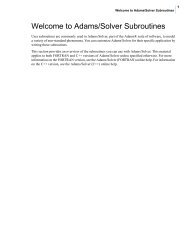Create successful ePaper yourself
Turn your PDF publications into a flip-book with our unique Google optimized e-Paper software.
4.4.1.6 String Format Specification<br />
<strong>Virtual</strong> <strong>Machine</strong> Reference, Model Customization<br />
The Macro Language, String Format Specification<br />
String formatting is used to read and write variables to external files, and to write information to<br />
the verification listing. Output string formatting converts variables to a text string. Input string<br />
formatting extracts information from a text string and loads it into variables.<br />
Output String Format Specifications<br />
String formatting is used to transfer different data types into a text format depending upon<br />
certain control characters in the format string. The format processing described below is used by<br />
the $FSWRIT function, and also by the ERROR and WRITE commands.<br />
A format string is made up of two separate parts. The first part is a character string that may or<br />
may not have certain control characters. The second part is a list of arguments that are to be<br />
formatted into the first part of the format string. The number of arguments required for the<br />
second part depends upon the number of control characters in the first.<br />
The following sections describe the action taken when certain control characters are found in the<br />
first part of the format string. Each control character may require a different type of argument in<br />
the second part of the format string. The type required will be described in the pertinent section.<br />
The exclamation character (!) is used as an attention character to indicate that the characters to<br />
follow are to be validated as formats for different argument types. If an exclamation character is<br />
required on the output string, specify two exclamation characters (!!). All formats should be<br />
placed in open and close parentheses. For example, “!(s4.3s)”.<br />
Numeric Output Format<br />
(!<br />
� �<br />
�� X�� V<br />
��� �s�<br />
n<br />
�.<br />
�<br />
n<br />
�s�<br />
)<br />
�� e��<br />
�� f��<br />
�� e��<br />
V Output as variable length string (default)<br />
X Output as fixed length string<br />
+ Output + sign for positive numbers<br />
s Suppress leading/trailing zeros<br />
e One digit must appear left or right of decimal<br />
n Maximum number of digits left or right of decimal<br />
. Always output decimal<br />
f Omit decimal point for whole numbers<br />
This format is used to place a value into the character string using a given “format”. This format<br />
requires a numeric argument for each occurrence of the format. This value can be any numeric<br />
value. The macro processor will take this value and format it using the specified “format”. The<br />
“format” can be in the following appearance.<br />
The “V” or “X” character provides for optional fixed length output. When using the X format,<br />
leading and trailing zeroes that are converted to blanks will remain significant. This is useful<br />
when outputting tables of values that should be aligned. The default is variable length output.<br />
The V format character can be omitted.<br />
<strong>ICAM</strong> Technologies Corporation – Proprietary 139















